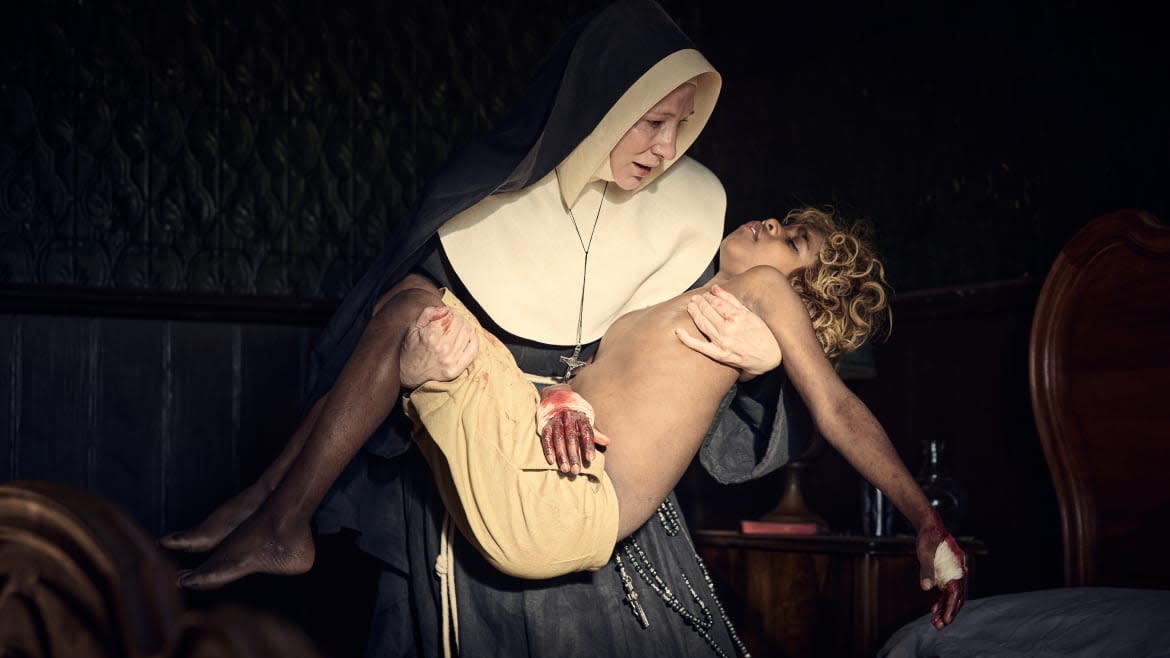Cate Blanchett’s New Film Is a Major Flop at Cannes

- Oops!Something went wrong.Please try again later.
- Oops!Something went wrong.Please try again later.
- Oops!Something went wrong.Please try again later.
This reviewer wasn’t expecting to be reminded of the Frank Darabont dud The Green Mile during the Cannes Film Festival, but Warwick Thornton’s The New Boy treads the same sort of line of hokey magic realism territory. A valiant but perhaps rather mannered performance by Cate Blanchett cannot rescue this movie from its turgid instincts.
As the film begins, the central character—a wild and nameless indigenous child, played somewhat gratingly by newcomer Aswan Reid—is presented to us against the magnificent backdrop of the Australian outback, where the boy tussles with a white captor before being kidnapped and delivered to a convent, writhing and struggling in a sack.
Here, Sister Eileen (Blanchett) has the guardianship of a gaggle of young boys, whom she looks after with the assistance of two helpers (Deborah Mailman and Wayne Blair). The second world war is raging all around, enabling the eccentric Sister Eileen to establish a much more loose and unconventional establishment than could have been expected. Here, the boy overcomes an initial onslaught of bullying from the other kids, and wins over his supervisors with his charmingly affectless ways—think Haley Joel Osment meets Nell and you’re in the right sort of territory.
A New Holocaust Film Masterpiece Just Debuted at Cannes
The boy, you see, is blessed with a sort of super-power, which enables him to heal others and to conjure magical sparks of dancing light from his fingertips. The glowing embers that the boy produces are depicted rather cheaply here, in a way that clashes with the film’s classical aesthetic; those tacky visuals contribute in large part to the movie’s unfortunately smarmy tone.
Again and again The New Boy enacts scenes of quasi-religious portent, drawing heavy parallels between the child’s pagan behavior and the life of Jesus, whose statue the boy seems to be drawn to. These examples of the child’s artless purity, eating with his hands but healing others, killing sheep but standing up to bullies, become tiresome because the film’s wide-eyed manner is so ingratiating.
Although there is beauty aplenty in The New Boy’s visual department, even this becomes somehow gloopy over time, feeding into the movie’s edgeless performance of ‘wonder’. In particular, the film’s color palette, ranging from gold to honey via oat, barley, wheat, yellow, beige, bronze and copper starts to pall rapidly. School children dressed in cream against a background of aureate fields drenched in sun; sparks flying; rows of corn; mustardy interiors: all that’s missing is “Yellow” by Coldplay.
Every scintilla of light here is magically dappled; every shot is iridescent. The effect strived for is clearly one of awe, which will help spectators connect with the story of a supernatural, spiritual being who can transfigure reality—but that awe never materializes. An abundance of slow-mo and fade-edits, and a somewhat stiff rhythm in the edit, don’t help matters.
Blanchett, as the nun who struggles to reconcile her faith with the boy’s powers, and the example he sets, offers a sturdy performance which nevertheless feeds into the film’s weirdly old-fashioned feel. You could imagine Anne Bancroft or Katharine Hepburn in a similar role, in an early 1960s film now half-forgotten: Sister Eileen is (of course!) not the mild nun you would expect, but a creature of flesh and blood, with a somewhat abrasive manner.
Everything About Johnny Depp at Cannes Was an Embarrassing Disaster
Blanchett is typically brisk, giving some rhythm and spontaneity to the movie’s more leaden dialogue and finding stuff with which to busy herself. She also finds comedy in the character, in a wonderful scene in which the sister shrilly leads the boys in song. But even this composition is hamstrung by The New Boy’s tendency for facility: for instance, in a scene in which Eileen is apprised of the new boy entering into conflict with other children, she remarks with what is intended to be a charming smirk, “I think that’s called the pecking order.” The tone here is stuffy and self-congratulatory, endlessly complimenting itself on its own raffish charm.
The New Boy’s exploration of aboriginal identity, embattled in this white environment but winning out through sheer force of will, is not without interest, even though the reliance on magical realism is sometimes a bit borderline. Thornton has chosen a deeply classical mode of expression, perhaps wishing to renounce the naturalism that some might expect. When The New Boy explicates its own racial and spiritual conflict, as the boy and the nun tussle with one another in the film’s mid-section, there is briefly some life, an actual spark of interest—but then, again, the characters are once more drowned in treacle.
Liked this review? Sign up to get our weekly See Skip newsletter every Tuesday and find out what new shows and movies are worth watching, and which aren’t.
Get the Daily Beast's biggest scoops and scandals delivered right to your inbox. Sign up now.
Stay informed and gain unlimited access to the Daily Beast's unmatched reporting. Subscribe now.

